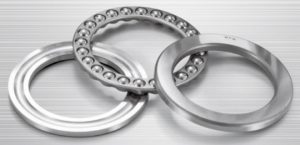What is meant by "point and line contact"?
You may have already heard that rolling bearings can be split into two types. The classification depends on the shape of the rolling elements (balls or rollers/needles), so that a basic distinction is made between ball and roller bearings.
The main difference between the two designs lies in the contact between the rolling elements and the raceway surface. Imagine a deep groove ball bearing and a cylindrical roller bearing: In a the deep groove ball bearing, the contact between the balls and the raceway is point-shaped from a geometrical point of view. Whereas in the rolling elements of a cylindrical roller bearing contact the raceway in a linear manner.
The advantages and disadvantages of point and line contact
Both types of contact have advantages and disadvantages. Point contact offers the advantage that ball bearings can be operated at a high speed. They are sometimes used in machine tools or electric motors. However, ball bearings cannot support as much load as roller bearings. The rolling elements of roller bearings offer a larger contact area to the raceways than balls. As a result, bearings with line contact can generally support higher loads than ball bearings and have greater stiffness. On the other hand, the frictional torque is higher than with ball bearings. Due to the linear contact, roller bearings are therefore used in applications with comparatively low speeds – for example in gearboxes.
You may also be interested in
Structure and function
Components of rolling bearings The basics of rolling bearing technology include the structure and function of rolling bearings. To get you started slowly, you will

The angular contact ball bearing
The angular contact ball bearing is virtually the brother of the deep groove ball bearing. Characteristics of angular contact ball bearings Perhaps you already know
The cylindrical roller bearing
Characteristics of cylindrical roller bearings Do you remember the characteristic that all roller bearings have in common? We are talking about line contact, which can
The deep groove ball bearing
Characteristics of deep groove ball bearings In its current form, the deep groove ball bearing has existed – subject to some optimisation – for about
The spherical roller bearing
Characteristics of spherical roller bearings Spherical roller bearings are real all-rounders. They are able to support heavy loads in both axial and radial directions. Spherical

The tapered roller bearing
Characteristics of tapered roller bearings Here you see an NTN tapered roller bearing. As the name suggests, tapered roller bearings are roller bearings, whereby the





